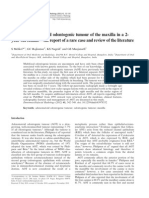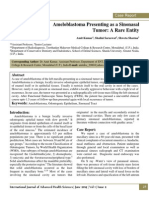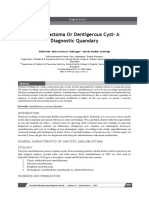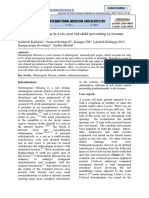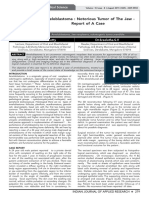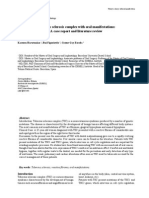Mandibular Ameloblastoma in A 10-Year-Old Child: Case Report and Review of The Literature
Mandibular Ameloblastoma in A 10-Year-Old Child: Case Report and Review of The Literature
Uploaded by
Widhi Satrio NugrohoCopyright:
Available Formats
Mandibular Ameloblastoma in A 10-Year-Old Child: Case Report and Review of The Literature
Mandibular Ameloblastoma in A 10-Year-Old Child: Case Report and Review of The Literature
Uploaded by
Widhi Satrio NugrohoOriginal Title
Copyright
Available Formats
Share this document
Did you find this document useful?
Is this content inappropriate?
Copyright:
Available Formats
Mandibular Ameloblastoma in A 10-Year-Old Child: Case Report and Review of The Literature
Mandibular Ameloblastoma in A 10-Year-Old Child: Case Report and Review of The Literature
Uploaded by
Widhi Satrio NugrohoCopyright:
Available Formats
Int. J. Odontostomat., 6(3):331-336, 2012.
Mandibular Ameloblastoma in a 10-year-old Child: Case Report and Review of the Literature
Ameloblastoma Mandibular en Nio de 10 Aos: Reporte de un Caso y Revisin de la Literatura
Edgar Belardo*; Ignacio Velasco**; Andrs Guerra* & Edwin Rosa**
BELARDO, E.; VELASCO, I.; GUERRA, A. & ROSA, E. Mandibular ameloblastoma in a 10-year-old child: case report and review of the literature. Int. J. Odontostomat., 6(3):331-336, 2012. ABSTRACT: The ameloblastoma according to the classification of odontogenic tumors by WHO in 2005, is classified as a benign neoplasm of odontogenic epithelial origin. One to three percent of tumors and cysts of the jaws are comprised of ameloblastomas. The tumor is locally aggressive, but often asymptomatic, showing a slow growth which is manifested as a facial swelling or radiographic incidental finding. On clinical examination, the tumor can cause symptoms such as pain, ulceration, tooth mobility, root resorption and malocclusion. Ameloblastomas have a high rate of recurrence if not completely removed. It occurs in almost all age groups, but is mainly diagnosed in the third or fourth decade of life. The tumor is very rare in children. We present an unusual case of a solid/multicystic ameloblastoma of the mandible in a 10-year-old girl. In addition, a brief review of the literature on reported cases of this pathology in children is also presented. KEY WORDS: solid ameloblastoma, multicystic ameloblastoma, odontogenic tumor, children.
INTRODUCTION
The ameloblastoma according to the classification of odontogenic tumors by WHO in 2005, is classified as a benign neoplasm of odontogenic epithelial origin (Barnes et al., 2005). One to three percent of tumors and cysts of the jaws are comprised of ameloblastomas (Small & Waldron, 1995; Reichart et al., 1995). Ameloblastoma is the most common odontogenic tumor (OT) in Africa (Arotiba et al., 1997; Ladeinde et al., 2005) and Asia (Wu & Chan, 1985) but is the second most common in South and North America (Regezi et al., 1978; Ochsenius et al., 2002). Ameloblastoma can theoretically arise from remnants of the dental lamina, enamel organ of developing tooth, the epithelial lining of odontogenic cyst or basal cells of the oral mucosa (Crawley & Levin, 1978; Leider et al., 1985). It occurs in almost all age groups, but mainly diagnosed in the third or fourth decade of life. Most cases (66%) affect the posterior mandible and ramus (Neville et al. , 2008). Ameloblastomas are usually asymptomatic and
* **
present as a slow growing facial swelling or as an incidental radiographic finding. Despite being a benign neoplasm, it is locally destructive and has a high rate of recurrence if not completely removed (Hong et al., 2007). The three clinical and radiographic presentations which have different prognostic and therapeutic considerations can include: 1) solid/ multicystic (86% of cases); 2) unicystic (13% of cases); 3) peripheral (1% of cases) (Neville et al.). Its classic radiographic presentation is that of a multilocular radiolucency. The expansion of the buccal and lingual cortices of bone, with the possibility of bone perforation and soft tissue extension is frequently observed. The resorption of roots of adjacent teeth is common and is often associated with an unerupted tooth. Most frequently, it is the mandibular third molar area which is involved (Dunfee et al., 2006). However, the solid/multicystic ameloblastoma may appear radiographically as a unilocular lesion resembling other cystic lesion (Hong et al.).
Professor, Department of Oral and Maxillofacial Surgery, University of Puerto Rico, Puerto Rico. Resident, Department of Oral and Maxillofacial Surgery, University of Puerto Rico, Puerto Rico.
331
BELARDO, E.; VELASCO, I.; GUERRA, A. & ROSA, E. Mandibular ameloblastoma in a 10-year-old child: case report and review of the literature. Int. J. Odontostomat., 6(3):331-336, 2012.
The clinico-pathologic characteristics are of a benign lesion with a slow growth pattern, but locally invasive. The clinical behavior can be considered between a benign and malignant lesion, and the high rate of recurrence is an important factor when determining the management of the lesion (Chapelle et al ., 2004). Therefore, the choice of treatment should be assessed based on the lesions clinical type (solid/multicystic, unicystic, peripheral), the location and size of tumor and patients age. The spectrum of treatment described in the literature range from simple bone curettage to segmental resection, but there are few criteria for treatment based on retrospective studies published. In this report we present the unusual case of a solid/multicystic ameloblastoma in the mandible of a 10-year-old girl. In addition, a brief review of the literature on reported cases of this pathology in children is also presented.
CASE REPORT
Fig. 2. a-b. Intraoral photographs showed remarkable buccal and lingual expansion of left mandibular body.
The patient is a 10-year-old Hispanic female, without history of medical conditions. She was consulted to the Oral and Maxillofacial Surgery Clinic at the University Pediatric Hospital (UPH) at the Medical Center in San Juan, Puerto Rico, due to a painless facial swelling in the left perimandibular area with three months of evolution. Extraoral clinical examination showed a mild facial swelling over the body of the left mandible, which was firm to palpation with a normal overlying skin (Fig. 1). Intraorally, the exam was remarkable for a buccal and lingual expansion of the mandibular left body, tender to palpation and covered with normal, healthy mucosa (Fig. 2). There were neither palpable neck masses nor lymphadenopathy and all cranial nerves were intact. The remaining physical exam was within normal limits. The patient had no relevant medical history and was taking no medication. The panorex and maxillofacial computed tomography (CT) requested revealed an extensive unilocular and radiolucent lesion with diffuse margins, localized to the left mandibular body extending from the canine to the first molar (3.6 cm antero-posterior and 2.3 cm width) and including the second premolar inside the lesion. Reabsorbtion of
Fig. 1. a-b. Extraoral photographs showed mild facial swelling over the body of the left mandible.
332
BELARDO, E.; VELASCO, I.; GUERRA, A. & ROSA, E. Mandibular ameloblastoma in a 10-year-old child: case report and review of the literature. Int. J. Odontostomat., 6(3):331-336, 2012.
Fig. 3. a- Panorex showed extensive unilocular, radiolucent lesion of left mandibular body and including the second premolar inside the lesion, b- CT axial views of bone window, the dimensions of the lesion were: 3.6 cm antero-posterior and 2.3 cm width.
Fig. 5. a. Submandibular approach to mandible. b. Mandibular resection and reconstruction plate placement.
Fig. 4. Histopathology, hematoxylin-eosin stain, original magnification 100x.
dentigerous cyst, primordial cyst, adenomatoid odontogenic tumor, keratocystic odontogenic tumor and unicystic ameloblastoma. The histopathologic examination demonstrated continuing islands of odontogenic epithelium set in a fibrous stroma. The epithelium consisted of basal cells resembling the enamel organ, showing cytoplasmic vacuolization and reverse polarization of the nuclei that resulted in solid/multicystic ameloblastoma (Fig. 4). The patient underwent treatment with a mandibular resection with safety margins of 1 cm, through a submandibular approach along with placement of a 2.4 mm mandibular reconstruction plate (KLS Martin LP, Jacksonville, Florida) (Fig. 5). Specimen X-Ray was obtained to check the bony margins (Fig. 6).
the roots of adjacent teeth and expansion of the buccal and lingual cortical plates with evident perforation in some areas were also noted (Fig. 3). The primary differential diagnoses contemplated for this lesion included an odontogenic cyst vs. an odontogenic tumor, however, a vascular lesion has to be always considered. The lesion was first aspirated prior to the extraction of the lower left deciduous first molar, through which an incisional biopsy was performed. Diagnostic hypothesis included:
333
BELARDO, E.; VELASCO, I.; GUERRA, A. & ROSA, E. Mandibular ameloblastoma in a 10-year-old child: case report and review of the literature. Int. J. Odontostomat., 6(3):331-336, 2012.
Post-operative radiographic evaluation showed adequate resection margins (Fig. 7) and the final pathology was consistent with the initial diagnosis of solid/multicystic ameloblastoma. The patient has had an uneventful recovery and at this time she is being observed for spontaneous regeneration of the mandible and will be scheduled for reconstructive surgery in the future. She will be followed every three months for the first year, and then twice a year for the next 4 years.
DISCUSSION
Ameloblastoma is uncommon in children. The most commonly cited article is a review of 1.036 cases, where the average age was 38.9 years with only 2.2% (19 of 858) under 10 years and 8.7% (75 of 858) between 10 and 19 (Small & Waldron). However, this report was published in 1955 when adenoameloblastoma and ameloblastic fibroma were considered ameloblastomas. The first report of ameloblastoma in children was in 1962, where 7 cases were reported in children under the age of 9 years old but 2 of these cases were ameloblastic fibromas and 1 case odontoameloblastoma (Young & Robinson, 1962). Ord et al. (2002) made a review of reported cases of ameloblastomas in children from 1970 to
Fig. 6. a. Surgical specimen. b. intraoperative radiography.
Fig. 7. Panorex, 1 day post-operative.
334
BELARDO, E.; VELASCO, I.; GUERRA, A. & ROSA, E. Mandibular ameloblastoma in a 10-year-old child: case report and review of the literature. Int. J. Odontostomat., 6(3):331-336, 2012.
2001, comparing Western and African reports. This review showed an average age of 14.3 years (Western) and 14.7 years (African) and confirms that less than 10% of cases occur in children under 10-years-old. In adults, the gender ratio is 1:1. In Western children the ratio is 1:1.2 for male/female. While in African children, there is a male predominance of 1.4:1. The mandible is the most affected in adult ameloblastomas (85%), the third molar region being the most common site. This pattern is reflected in Western children where the angle of the mandible is affected 72% and the mandibular symphysis 5.8%. In contrast, African children were affected in the angle of the mandible 27.3% and in the mandibular symphysis 44.2%. The unicystic ameloblastoma variant is more common in Western children (76.5%). The solid/multicystic ameloblastoma is rare in children but in African children is the most prevalent (59.8%) assimilating the adult pattern. Ameloblastoma treatment in children would be complicated by 3 factors (Ord et al.): 1) The continued growth and facial bone physiology (higher percentage of cancellous bone, increased bone turnover and high periosteal reactivity), as well the presence of unerupted teeth. 2) Difficult initial diagnosis. 3) Predominance of AB unicystic type. The diagnosis of ameloblastoma in children is difficult because most of the lesions radiographically resemble dentigerous cyst. Studies associate ameloblastoma with an unerupted tooth in the range of 70% to 83%, and in our case is associated with a second premolar but is most frequently associated with the mandibular third molar (Robinson & Martinez, 1977; Shteyer et al., 1978). This radiographical
similarity with dentigerous cyst would lead to initial treatment, marsupialization, curettage or enucleation. And only when the specimen is analyzed completely, definitive diagnosis is made and at that point one it should be determined if another treatment is necessary. The basis of treatment in adults is surgery, resection with safety margins of 1-1.5 cm is recommended due to the high rate of recurrence of the solid/multicystic ameloblastoma. The recurrence rate after resection is close to 5% compared with the 90-100% of the curettage and enucleation (Chapelle et al.). In the treatment of children some authors recommend enucleation or only minimal treatment (Rapidis et al., 1982; Isaacsson et al., 1986), while Fung et al. (1978) suggests that due to the greater amount of cancellous bone in young patients, the lesion would have a more aggressive course with more destruction, making the surgical procedure more difficult and demanding. Ameloblastoma management remains controversial, but Ord et al. states that the solid/ multicystic ameloblastoma or recurrent lesions in children should be treated with mandibular resection in the same way adults are treated. Their cases are treated with mandibular resection with a safety margin of 1 cm of cancellous bone and soft tissue resection if there was cortical perforation. Our reported case was treated in this way with reconstruction plate placement. Monitoring is essential in these patients because most recurrences occur within the first 5 years. However, some recurrences have been observed beyond 10 years after initial treatment (Dunfee et al.).
BELARDO, E.; VELASCO, I.; GUERRA, A. & ROSA, E. Ameloblastoma mandibular en nio de 10 aos: reporte de un caso y revisin de la literatura. Int. J. Odontostomat., 6(3) :331-336, 2012. RESUMEN: El ameloblastoma segn la clasificacin de tumores odontognicos de la OMS del 2005 lo clasifica como una neoplasia benigna de origen epitelial odontognico. Compromete el 1-3% de neoplasias y quistes maxilares. El tumor es agresivo localmente, pero muchas veces asintomtico; presenta un lento crecimiento que se manifiesta como un aumento de volumen facial o un hallazgo incidental radiogrfico. Al examen clnico el tumor puede causar sntomas como dolor, ulceracin, reabsorcin radicular con movilidad dentaria y maloclusin. El ameloblastoma posee gran tasa de recurrencia si no es totalmente removido. Se presenta en casi todos los grupos etarios pero principalmente se diagnostica en la tercera o cuarta dcada de vida, el tumor es muy poco comn en nios. El tratamiento del ameloblastoma es controversial y debido a la distinta incidencia y comportamiento en nios, hace las consideraciones quirrgicas diferentes a los adultos. Por lo que presentamos un inusual caso de un ameloblastoma solido/multiqustico mandibular en una nia de 10 aos. Adems de una breve revisin de la literatura sobre casos reportados de esta patologa en nios. PALABRAS CLAVE: ameloblastoma solido, ameloblastoma multiqustico, tumores odontognicos, nios.
335
BELARDO, E.; VELASCO, I.; GUERRA, A. & ROSA, E. Mandibular ameloblastoma in a 10-year-old child: case report and review of the literature. Int. J. Odontostomat., 6(3):331-336, 2012.
REFERENCES
Oral and Maxillofacial Pathology. 3rd ed. St. Louis, Saunders, 2008. pp.701-8. Ochsenius, G.; Ortega, A.; Godoy, L.; Penafiel, C. & Escobar, E. Odontogenic tumors in Chile: a study of 362 cases. J. Oral Pathol. Med., 31(7):415-20, 2002. Ord, R. A.; Blanchaert, R. H. Jr.; Nikitakis, N. G. & Sauk, J. J. Ameloblastoma in children. J. Oral Maxillofac. Surg., 60(7):762-70, 2002. Rapidis, A. D.; Angelopoulos, A. P.; Skouteris, C. A. & Papanicolaou S. Mural (intracystic) ameloblastoma. Int. J. Oral Surg., 11(3):166-74, 1982. Regezi, J. A.; Kerr, D. A. & Courtney, R. M. Odontogenic tumours: analysis of 706 cases. J. Oral Surg., 36(10):771-8, 1978. Reichart, P. A.; Philipsen, H. P. & Sonner, S. Ameloblastoma: biological profile of 3677 cases. Eur. J. Cancer B Oral Oncol., 31B(2):86-99, 1995. Robinson, L. & Martinez, M. G. Unicystic ameloastoma: A prognostically distinct entity. Cancer, 40(5):227885, 1977. Shteyer, A.; Lustmann, J. & Lewis-Epstein, J. The mural ameloblastoma: A review of the literature. J. Oral Surg., 36(11):866-72, 1978. Small, L. A. & Waldron, C. A. Ameloblastoma of the jaws. Oral Surg. Oral Med. Oral Pathol., 8:281-97, 1955. Wu, P. C. & Chan, K. W. A survey of tumours of the jaw bone in Hong Kong Chinese: 19631982. Br. J. Oral Maxillofac. Surg., 23(2):92-102, 1985. Young, D. R. & Robinson, M. Ameloblastomas in children. Oral Surg. Oral Med. Oral Pathol., 15:1155-62, 1962.
Correspondence to: Dr. Ignacio Velasco Martinez. Av. Pasaje Republica de Honduras interior 12.279 Zip: 7550000 Santiago CHILE Email: iavelasco@miuandes.cl Received: 13-04-2012 Accepted: 26-06-2012
Arotiba, J. T.; Ogunbiyi, J. O. & Obiechina, A. E. Odontogenic tumours: a 15-year review from Ibadan, Nigeria. Br.
J. Oral Maxillofac. Surg., 35(5):363-7, 1997. Barnes, L.; Eveson, J. W.; Reichart, P. & Sidransky, D. World health organization classification of tumours: Head and neck tumours. Lyon, France, IARC Press, 2005. pp.284-302. Chapelle, K. A.; Stoelinga, P. J.; de Wilde, P. C.; Brouns, J. J. & Voorsmit, R. A. Rational approach to diagnosis and treatment of ameloblastomas and odontogenic keratocysts. Br. J. Oral Maxillofac. Surg., 42(5):381-90, 2004. Crawley, W. A. & Levin, L. S. Treatment of the ameloblastoma: a controversy. Cancer, 42(1):35763, 1978. Dunfee, B. L.; Sakai, O.; Pistey, R. & Gohel, A. Radiologic and pathologic characteristics of benign and malignant lesions of the mandible. Radiographics, 26(6):1751-68, 2006. Fung, E. M. Ameloblastomas. Int. J. Oral Surg., 7:305, 1978. Hong, J.; Yun, P. Y.; Chung, I. H.; Myoung, H.; Suh, J. D.; Seo, B. M.; Lee, J. H. & Choung, P. H. Longterm follow up on recurrence of 305 ameloblastoma cases. Int. J. Oral Maxillofac. Surg., 36(4):283-8, 2007. Isaacsson, G.; Andersson, L.; Fosslund, H.; Bodin, I. & Thomsson, M. Diagnosis and treatment of unicystic ameloblastoma. Int. J. Oral Maxillofac. Surg., 15(6):759-64, 1986. Ladeinde, A. L.; Ajayi, O. F.; Ogunlewe, M. O.; Adeyemo, W. L.; Arotiba, G. T.; Bamgbose, B. O. & Akinwande, J. A. Odontogenic tumors: a retrospective analysis of 319 cases in a Nigerian teaching hospital. Oral Surg. Oral Med. Oral Pathol. Oral Radiol. Endod., 99(2):191-5, 2005. Leider, A. S.; Eversole, L. R. & Barkin, M. E. Cystic ameloblastoma: A clinicopathologic analysis. Oral Surg. Oral Med. Oral Pathol., 60(6):624-30, 1985. Neville, B. W.; Damm, D. D.; Allen, C. M. & Bouqout, J.
336
You might also like
- Prognostic Influence of Bio Markers in Oral Cancer IJMOS 2011 - v5n3 - 014Document7 pagesPrognostic Influence of Bio Markers in Oral Cancer IJMOS 2011 - v5n3 - 014lucineioliveiraNo ratings yet
- Conservative Treatment of Ameloblastoma in Child: A Case ReportDocument4 pagesConservative Treatment of Ameloblastoma in Child: A Case ReportapriamaliaNo ratings yet
- Bilateral Adenomatoid Odontogenic Tumour of The Maxilla in A 2-Year-Old Female-The Report of A Rare Case and Review of The LiteratureDocument7 pagesBilateral Adenomatoid Odontogenic Tumour of The Maxilla in A 2-Year-Old Female-The Report of A Rare Case and Review of The LiteratureStephanie LyonsNo ratings yet
- Amelo 2011 I PressDocument7 pagesAmelo 2011 I PressChristian Ivan SantosoNo ratings yet
- Case Report Ameloblastic Fibroma: Report of 3 Cases and Literature ReviewDocument5 pagesCase Report Ameloblastic Fibroma: Report of 3 Cases and Literature ReviewcareNo ratings yet
- Follicular With Plexiform Ameloblastoma in Anterior Mandible: Report of Case and Literature ReviewDocument6 pagesFollicular With Plexiform Ameloblastoma in Anterior Mandible: Report of Case and Literature Reviewluckytung07No ratings yet
- Cabt 12 I 6 P 244Document4 pagesCabt 12 I 6 P 244Ezza RiezaNo ratings yet
- Ameloblastic Fibroma: Report of A Case: Su-Gwan Kim, DDS, PHD, and Hyun-Seon Jang, DDS, PHDDocument3 pagesAmeloblastic Fibroma: Report of A Case: Su-Gwan Kim, DDS, PHD, and Hyun-Seon Jang, DDS, PHDdoktergigikoeNo ratings yet
- Journal of Cranio-Maxillo-Facial Surgery: Ezekiel Taiwo Adebayo, Benjamin Fomete, Emmanuel Oladepo AdekeyeDocument4 pagesJournal of Cranio-Maxillo-Facial Surgery: Ezekiel Taiwo Adebayo, Benjamin Fomete, Emmanuel Oladepo Adekeyeboye022694No ratings yet
- Satnam Sir LeioDocument15 pagesSatnam Sir LeiobubblyNo ratings yet
- Cemento-Ossifying Fibroma of The Mandible: Presentation of A Case and Review of The LiteratureDocument5 pagesCemento-Ossifying Fibroma of The Mandible: Presentation of A Case and Review of The LiteratureMutia Martha HeldaNo ratings yet
- Ameloblastoma of Sinonasal Origin:a Rare EntityDocument4 pagesAmeloblastoma of Sinonasal Origin:a Rare EntityAmitSharmaNo ratings yet
- dmf2SA Presentasi01Document5 pagesdmf2SA Presentasi01Iftinan LQNo ratings yet
- Case Report The Challenging Diagnosis of Primordial Odontogenic TumorDocument5 pagesCase Report The Challenging Diagnosis of Primordial Odontogenic Tumorlee zaraNo ratings yet
- Tumor Odontogenico EscamosoDocument4 pagesTumor Odontogenico Escamosoメカ バルカNo ratings yet
- Juvenile Ossifying Fibroma of The Mandible: A Case ReportDocument7 pagesJuvenile Ossifying Fibroma of The Mandible: A Case Reportsagarjangam123No ratings yet
- Ameloblastoma of The Jaw and Maxillary Bone: Clinical Study and Report of Our ExperienceDocument7 pagesAmeloblastoma of The Jaw and Maxillary Bone: Clinical Study and Report of Our ExperienceKharismaNisaNo ratings yet
- Unicystic Ameloblastoma: A Diagnostic Dilemma and Its Management Using Free Fibula Graft: An Unusual Case ReportDocument4 pagesUnicystic Ameloblastoma: A Diagnostic Dilemma and Its Management Using Free Fibula Graft: An Unusual Case ReportCah YaniNo ratings yet
- JPNR - S04 - 233Document6 pagesJPNR - S04 - 233Ferisa paraswatiNo ratings yet
- Jurnal Ameloblastoma 1Document3 pagesJurnal Ameloblastoma 1riezki_amalia8No ratings yet
- Jurnal in EnglishDocument5 pagesJurnal in Englishyeni_arnasNo ratings yet
- 333 FullDocument6 pages333 FullImara BQNo ratings yet
- Art 04Document5 pagesArt 04aleon85No ratings yet
- Ameloblastoma: A Clinicoradiographic and Histopathologic Correlation of 11 Cases Seen in Goa During 2008-2012Document6 pagesAmeloblastoma: A Clinicoradiographic and Histopathologic Correlation of 11 Cases Seen in Goa During 2008-2012Tiara NurhasanahNo ratings yet
- Maxillary Ameloblastic Fibroma: A Case ReportDocument4 pagesMaxillary Ameloblastic Fibroma: A Case ReportJeyachandran MariappanNo ratings yet
- Odontogenic FibromaDocument5 pagesOdontogenic FibromaGowthamChandraSrungavarapuNo ratings yet
- Saudi Journal of Pathology and Microbiology (SJPM) : Case ReportDocument3 pagesSaudi Journal of Pathology and Microbiology (SJPM) : Case ReportSuman ChaturvediNo ratings yet
- Li Tiejun2006Document8 pagesLi Tiejun2006Herpika DianaNo ratings yet
- Jurnal InterDocument3 pagesJurnal InterMarsha AlexandraNo ratings yet
- AmeloblastomaDocument6 pagesAmeloblastomaNASTYHAIR 24No ratings yet
- PMR 2 1 6Document4 pagesPMR 2 1 6Adrian PermadiNo ratings yet
- Pi Is 1991790213000792Document6 pagesPi Is 1991790213000792dr.filipcristian87No ratings yet
- AmeloblastomaDocument4 pagesAmeloblastomaMarïsa CastellonNo ratings yet
- Ajodo Dec 10-1Document2 pagesAjodo Dec 10-1dradeelNo ratings yet
- Global Incidence and Profil AmeloblastomaDocument15 pagesGlobal Incidence and Profil AmeloblastomapriskayoviNo ratings yet
- Art 12Document4 pagesArt 12Adelina MijaicheNo ratings yet
- Calcifying Epithelial Odontogenic Tumor - A Case Series Spanning 25 Years and Review of The LiteratureDocument10 pagesCalcifying Epithelial Odontogenic Tumor - A Case Series Spanning 25 Years and Review of The Literaturesyifa qushoyyiNo ratings yet
- Osteoma 1Document3 pagesOsteoma 1Herpika DianaNo ratings yet
- Calcifying Epithelial Odontogenic Tumor - A CaseDocument5 pagesCalcifying Epithelial Odontogenic Tumor - A CaseKharismaNisaNo ratings yet
- Journal Pre-Proof: Oral Surg Oral Med Oral Pathol Oral RadiolDocument23 pagesJournal Pre-Proof: Oral Surg Oral Med Oral Pathol Oral Radiolabhishekjha0082No ratings yet
- Epulis KongenitalDocument3 pagesEpulis KongenitalFriadi NataNo ratings yet
- En Original2 PDFDocument7 pagesEn Original2 PDFsriwahyuutamiNo ratings yet
- CEOT in ChildDocument7 pagesCEOT in ChildlilaNo ratings yet
- Unicystic AmeloblastomaDocument6 pagesUnicystic AmeloblastomaignielNo ratings yet
- Mandibular Traumatic Peripheral Osteoma: A Case ReportDocument5 pagesMandibular Traumatic Peripheral Osteoma: A Case ReportrajtanniruNo ratings yet
- Oral and Maxillofacial Surgery Cases: Emtenan Abdulrahmman Almajid, Alia Khalid AlfadhelDocument5 pagesOral and Maxillofacial Surgery Cases: Emtenan Abdulrahmman Almajid, Alia Khalid AlfadhelAmadea EmanuelaNo ratings yet
- Ameloblastoma Arising in The Wall of Dentigerous Cyst - A Case ReportDocument3 pagesAmeloblastoma Arising in The Wall of Dentigerous Cyst - A Case ReportSenussi IbtisamNo ratings yet
- Ameloblastoma: A Clinical Review and Trends in ManagementDocument13 pagesAmeloblastoma: A Clinical Review and Trends in ManagementEzza RiezaNo ratings yet
- Juvenile Ossifying Fibroma of The Mandible: A Case ReportDocument7 pagesJuvenile Ossifying Fibroma of The Mandible: A Case Reportabeer alrofaeyNo ratings yet
- Odontogenic Keratocyst: A 10 Year Follow-Up Clinical Case ReportDocument7 pagesOdontogenic Keratocyst: A 10 Year Follow-Up Clinical Case ReportEstefany CobaNo ratings yet
- 2022 Article 1694Document9 pages2022 Article 1694Amal BoualiNo ratings yet
- Ameloblastoma Report CaseDocument6 pagesAmeloblastoma Report CaseYuzketNo ratings yet
- Metaanalysis of The Epidemiology and Clinical Manifestations of OdontomasDocument5 pagesMetaanalysis of The Epidemiology and Clinical Manifestations of Odontomasay lmaoNo ratings yet
- Ameloblastoma: Notorious Tumor of The Jaw - Report of A CaseDocument3 pagesAmeloblastoma: Notorious Tumor of The Jaw - Report of A CaseUwie MoumootNo ratings yet
- Ameloblastic Fibro-Dentinoma of Mandible: A Case ReportDocument3 pagesAmeloblastic Fibro-Dentinoma of Mandible: A Case ReportBrutusRexNo ratings yet
- Dr. Yoseph - The Role of Radiotherapy in The Management of Ameloblastoma and Ameloblastic CarcinomaDocument10 pagesDr. Yoseph - The Role of Radiotherapy in The Management of Ameloblastoma and Ameloblastic CarcinomaOnkologi Radiasi Angkatan 23No ratings yet
- JDS 17 370Document15 pagesJDS 17 370Ferry HendrawanNo ratings yet
- Esclerosis TuberosaDocument4 pagesEsclerosis TuberosaJesus NietoNo ratings yet
- BrazJOralSci 2007 Vol6 Issue21 p1364Document3 pagesBrazJOralSci 2007 Vol6 Issue21 p1364Inesza Sylviane AndariNo ratings yet
- Ameloblastoma Unveiled: A Comprehensive Journey Through Pathogenesis, Diagnosis, Treatment, and AdvocacyFrom EverandAmeloblastoma Unveiled: A Comprehensive Journey Through Pathogenesis, Diagnosis, Treatment, and AdvocacyNo ratings yet
- Periodontal Considerations in Fixed Prostheses PDFDocument5 pagesPeriodontal Considerations in Fixed Prostheses PDFWidhi Satrio NugrohoNo ratings yet
- Protaper PDFDocument5 pagesProtaper PDFWidhi Satrio NugrohoNo ratings yet
- Product/Service Information: Main Inside HeadingDocument3 pagesProduct/Service Information: Main Inside HeadingWidhi Satrio NugrohoNo ratings yet
- CobaDocument2 pagesCobaWidhi Satrio NugrohoNo ratings yet
- Chronic Gastritis and Peptic Ulcer Disease: Rahma LabatjoDocument15 pagesChronic Gastritis and Peptic Ulcer Disease: Rahma LabatjorahmaNo ratings yet
- Clinical Cancer Research Word TemplateDocument7 pagesClinical Cancer Research Word TemplateDoctor EbrahimNo ratings yet
- BRONJ (Bisphosphonates-Related Osteonecrosis of The Jaw)Document3 pagesBRONJ (Bisphosphonates-Related Osteonecrosis of The Jaw)drfarazNo ratings yet
- Chemical Hazards & Chemical Safety ManagementDocument45 pagesChemical Hazards & Chemical Safety ManagementAziful AimanNo ratings yet
- MastrubationDocument10 pagesMastrubationMohammed SabeelNo ratings yet
- LutsDocument35 pagesLutsJulian Eka Putra100% (1)
- PancreatitisDocument2 pagesPancreatitisThomcris PatalinghugNo ratings yet
- Fetomaternal Hemorrhage (FMH), An Update Review of LiteratureDocument35 pagesFetomaternal Hemorrhage (FMH), An Update Review of LiteratureEugenia Jeniffer JNo ratings yet
- Uso Medicinal de Cordia LuteaDocument12 pagesUso Medicinal de Cordia LuteaBelen GonzalezNo ratings yet
- Polyarteritis NodosaDocument6 pagesPolyarteritis NodosaEkaNo ratings yet
- Ayurved TerminologiesDocument30 pagesAyurved TerminologiesVipul RaichuraNo ratings yet
- Lecture VIII - PdfpedoDocument13 pagesLecture VIII - PdfpedoNoor Abdullah AlNo ratings yet
- 2016 Nutrition Month Talking PointsDocument28 pages2016 Nutrition Month Talking PointsEli Benjamin Nava Taclino89% (9)
- Sample Pages of RadiologyDocument17 pagesSample Pages of RadiologyskNo ratings yet
- Endocrine HTNDocument32 pagesEndocrine HTNatik mayasariNo ratings yet
- Characteristics of Pitta TypeDocument3 pagesCharacteristics of Pitta TypeSwami KarunakaranandaNo ratings yet
- Vit C The Mother of All VitsDocument28 pagesVit C The Mother of All VitsMa Karla Ligaya Castro100% (1)
- ARTEFACTSDocument58 pagesARTEFACTSLavanya Kalapala100% (1)
- Lung CancerDocument4 pagesLung Cancerjorgeacct100% (1)
- DenosumabDocument2 pagesDenosumabMahdy AlShammariNo ratings yet
- Risk Assesment Location: LABUAN TIMES Square Phase 2 Date: Conducted By: Title: External Manual Painting Review By: Alastair Louis Approved byDocument2 pagesRisk Assesment Location: LABUAN TIMES Square Phase 2 Date: Conducted By: Title: External Manual Painting Review By: Alastair Louis Approved byLester LouisNo ratings yet
- Pharos: of Alpha Omega Alpha Honor Medical Society Winter 2009Document53 pagesPharos: of Alpha Omega Alpha Honor Medical Society Winter 2009Abner YaribNo ratings yet
- CAD, HPN, HyperlipidemiaDocument8 pagesCAD, HPN, Hyperlipidemiasarguss14100% (2)
- Alan Anderson Bangun 22010110120053 Bab2ktiDocument6 pagesAlan Anderson Bangun 22010110120053 Bab2ktikhusnulNo ratings yet
- PathologyDocument4 pagesPathologyvenkatgayatri5No ratings yet
- Coding Skin Procedures in The Office Setting: All Rights Reserved AAPCDocument20 pagesCoding Skin Procedures in The Office Setting: All Rights Reserved AAPCvrushgangNo ratings yet
- Weber 2020Document11 pagesWeber 2020Yefry Onil Santana MarteNo ratings yet
- Junk Food PDFDocument6 pagesJunk Food PDFAswath .SNo ratings yet
- CEBM Levels of Evidence Introduction 2.1Document3 pagesCEBM Levels of Evidence Introduction 2.1Anida SaNiia BecKzNo ratings yet
- Osce Book 3rdDocument39 pagesOsce Book 3rdأحمد الكندي100% (1)


